Iowa City community members learn about the business of urban farming.
By Autumn Diesburg
With urban farming continuing to take hold in communities, would-be urban farmers are considering the logistics of owning and profiting from what seems to some to be an unorthodox business.
At a Practical Farmers of Iowa Field Day on June 24, members of the Iowa City community gathered to learn more about the business of urban farming. Hosted by urban farmer Jon Yagla and the Women Food and Agriculture Network program coordinator Wren Almitra, the program discussed the various facets of urban farming, including Yagla’s business plan and financing.
“Sometimes, it makes sense to grow greens and sell to restaurants,” Yagla said. “The [community-supported agriculture] worked for me.”
Yagla said his business plan relied on growing food as an extension of homesteading for community-supported agriculture, which Almitra said is a “member-based farm business.”
Members purchase either a full share for $750 or a half share for $375 in a farm, Yagla said. The program has a 30-week season lasting from the first week of May to the last week of November. Most members pay an upfront deposit in late winter or early spring, usually beginning in February or March. This allows farmers to pay for seeds and equipment in a time when, otherwise, they are producing no income, Yagla said. In return, full-share members receive a box of produce every week, and half-share members receive a box every other week.
Currently, Yagla said he has 30 members in his group, which is mostly a word-of-mouth endeavor. Potential members contact Yagla or other local community-agriculture groups, though the group does have social-media and Internet sites for outreach and promotion.
RELATED: ‘New age’ farmers grow local produce year-round
Yagla said in regards to financial planning, he recommends keeping both living and business expenses low, knowing and being a part of available markets, and having some experience with farming or homesteading. He also recommends scaling the size of community agriculture to the size of the budget.
Careful financial planning is key for Yagla, who said his only source of income is what he earns from his urban farm. In 2016, he grossed $15,000 with a net of $12,000.
“The [community-agriculture] size was based on what I thought my living expenses and my needs are and how much land I could manage,” he said. “I’m about as frugal as I can be.”
For those such as Debra Boekholder, a Practical Farmers of Iowa member and events assistant, the gains of urban farming are a good local food source.
“It is a solution to struggles with access to healthy foods,” she said. “You can grow food in town and provide it to your neighbors. You don’t have to go miles and miles.”
Still, others such as Abbie Shain, a graduate student in social work in St. Paul, Minnesota, have yet to be persuaded on the practicality of urban farms. Shain said after working on urban farms in St. Paul and Minneapolis, she would not consider starting one.
“It was not successful,” she said. “It was successful at growing vegetables but not sustaining farmers.”
Yagla, however, said owning an urban farm is profitable and a worthwhile community cause.
“The gain is that it’s meaningful work that reduces exploitation,” he said. “It’s a way for people to get food locally and honestly. I want to produce [a] local economy where goods are produced and shared among neighbors and friends.”







